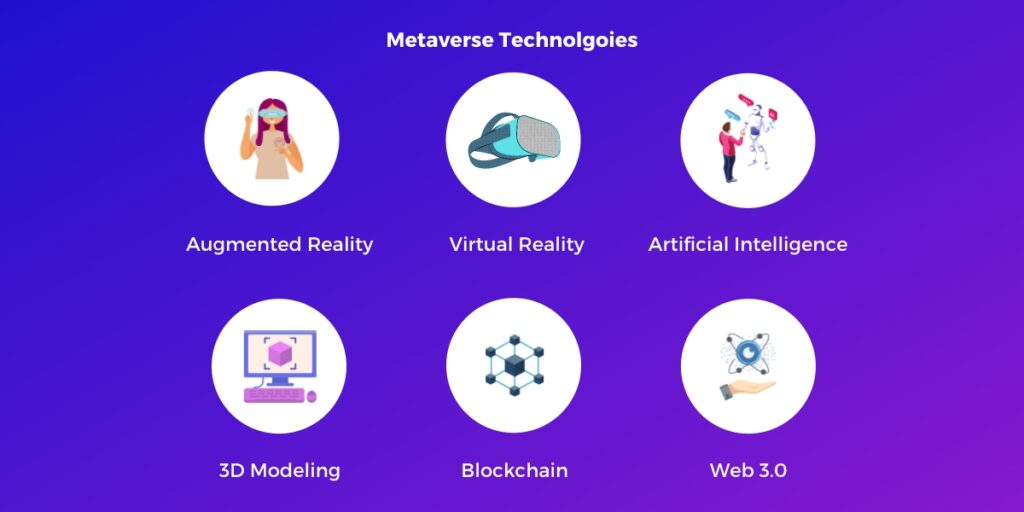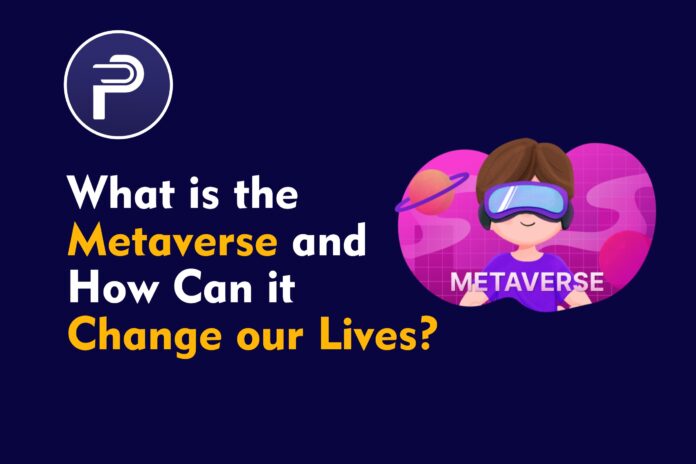What is The Metaverse?

The metaverse, poised as the next evolutionary stage of the internet, represents a three-dimensional environment enabling lifelike interactions and fully immersive experiences ranging from shopping to fitness activities. Fueled by a fusion of technologies such as virtual reality (VR), augmented reality (AR), and artificial intelligence (AI), these virtual realms are brought to fruition. Leading the charge in this transformation are platforms like Spatial, Roblox, and Fortnite, which offer users unprecedented levels of immersion and instantaneous interaction, extending beyond gaming into realms of entertainment, education, and collaborative work.
Must Read:Elon Musk Announces First Neuralink Chip Implant in The Human Brain
What The Metaverse Covers and How it Can Change Our Lives
Marketing
Businesses are integrating the metaverse into their marketing strategies to showcase their brands within dynamic, interactive 3D settings. Consumers have the opportunity to interact with digital renditions of products, virtually try them on, or arrange and situate them within virtual landscapes. Moreover, brands can craft captivating 3D environments to convey their company’s narrative and story, offering a unique avenue for customer engagement and the creation of immersive brand encounters. For example, Lush collaborated with Landvault to develop a 3D experience within Decentraland, targeting new demographics. This initiative allowed users to partake in various activities such as games, dance-offs, and treasure hunts while exploring the brand’s product offerings within a three-dimensional realm.
Real Estate
Real estate developers leverage the metaverse for design prototyping prior to construction and for seamless collaboration with stakeholders throughout the design phase. The metaverse’s high-fidelity, three-dimensional graphics are also well-suited for property realtors to deliver virtual tours of available locations, expanding their reach globally while minimizing environmental footprints. Additionally, within the 3D internet, users can engage in transactions involving buying, selling, and developing virtual properties, fostering a burgeoning digital real estate market brimming with investment and innovation prospects.
Events
The metaverse stands as an exceptional platform for hosting virtual gatherings, spanning from concerts to conferences, delivering an unparalleled level of immersion that engenders a sense of physical presence among attendees. By organizing events in the metaverse, the necessity for physical infrastructure, travel, and accommodation expenses is significantly reduced, rendering it both cost-effective and appealing for hosts and participants alike. The immersive quality of these events, driven by advanced virtual reality technologies, enriches the user experience, offering a unique selling proposition (USP) unmatched by traditional events. An exemplary instance of a metaverse event is Decentraland’s Metaverse Fashion Week, which united over 60 brands and attracted 300,000 attendees worldwide during its three-day festival. Users were able to participate in the event as avatars, explore brand-customized stores, attend live fashion shows, and procure both physical and virtual products.
Urban Development
The metaverse presents a groundbreaking platform for urban planning and development, facilitating the virtual modeling and visualization of urban initiatives. This methodology enables meticulous planning and experimentation with urban designs prior to initiating any physical construction, thereby enhancing decision-making processes and fostering community involvement. A prominent illustration of metaverse technologies applied in urban planning is evident in Saudi Arabia’s NEOM city project, wherein developers are investing in the creation of a digital twin to aid in the city’s construction and design endeavors.
Financial Services
Financial institutions, including banks, have the opportunity to extend their reach into the metaverse, connecting and engaging with customers through virtual branches. These spaces can be enhanced by service providers with gamified experiences, virtual avatars for assistance, and reward mechanisms to foster customer loyalty. For instance, Commercial Bank International (CBI), based in Dubai, is among the financial institutions that have established a virtual presence on Decentraland, seamlessly blending physical and digital experiences to better serve customers.
The technology behind it

Virtual reality (VR) and augmented reality (AR)
Virtual Reality (VR) and Augmented Reality (AR) play crucial roles in creating immersive experiences within the metaverse, enabling users to engage with digital environments in a realistic manner. VR enables users to immerse themselves in three-dimensional virtual worlds, whereas AR overlays computer-generated 3D imagery onto the real-world environment. Key technologies such as the Meta Quest and Microsoft HoloLens headsets are instrumental in enabling individuals to access metaverse experiences.
Artificial intelligence (AI)
AI powers dynamic and responsive environments within the 3D internet, from natural language processing for virtual assistants to generative AI tools for creators to build the metaverse. A leading software in the space, Landvault Create, is a no-code AI assistant that streamlines the development of virtual spaces. It uses procedural generation and AI to help users and creators build 3D spaces quickly with simple prompts.
3D Modelling
Essential for creating detailed virtual worlds, 3D reconstruction technology allows for digitizing real-world objects and environments into high-fidelity 3D models. This technology is critical for achieving realism and depth in the metaverse. Unreal Engine and Unity are prominent software in the market that help develop advanced 3D models and interactive visuals for the metaverse.
Blockchain
These technologies underpin the metaverse’s web3 economy, providing a secure, transparent transaction framework. Blockchain’s decentralized nature ensures that digital assets and non-fungible tokens (NFTs), like land or items in the 3D internet, are owned securely and can be traded or monetized. Blockchain networks also allow for decentralized storage of large amounts of data that prevents the metaverse from running low on space and is independent of third-party ownership.
Cloud computing
Cloud computing enables scalability and accessibility in the metaverse’s real-time, high-fidelity virtual environments, offering the computational power needed to handle vast amounts of data for complex simulations.
Web3
In the metaverse realm, engines like Unreal Engine, Unity, and CryEngine are pivotal in crafting high-fidelity immersive experiences. With its superior 3D graphics, Unreal Engine brings unparalleled realism, making virtual worlds more engaging and lifelike. Unity supports high-quality visuals across a broad spectrum of AR and VR platforms, making it ideal for developers to create complex, interactive virtual environments.
Integrating blockchain technology with these 3D-generated assets and environments introduces a layer of security and authenticity. The decentralized, tamper-proof ledger of blockchain ensures that assets, such as virtual real estate or in-game items, remain secure, uncopyable, and theft-proof. This foundational security is vital for fostering trust and stability within the metaverse economy.
The monetization of digital assets through non-fungible tokens (NFTs) marks a significant innovation within the digital economy of the 3D internet. By tokenizing 3D items, properties, or experiences as NFTs, creators, and users can own and profit from unique digital items, opening new economic opportunities. The virtual fashion industry, for instance, has seen significant success, with digital clothing selling for thousands of dollars. Dolce & Gabbana’s NFT couture collection set a record value of $6 million in the virtual market. The process of tokenizing these assets involves creating, minting on a blockchain to certify authenticity, and listing on marketplaces for trade, with platforms like Matera simplifying this process for broader accessibility.
The advent of web3 and blockchain technology heralds a new era of decentralization and user sovereignty in the metaverse. This technological synergy allows for more democratic and user-centric governance and economic models, empowering users with greater control over their data and digital assets. This evolution towards a more decentralized internet, or Web3, aligns perfectly with the ethos of the 3D internet, promising a future where virtual spaces are more immersive, secure, and user-driven.
What lies ahead?
Imagine a world where the internet isn’t just something you browse but a space you inhabit. The future metaverse will likely transform our 2D web pages into 3D environments, where websites become explorable spaces and social media platforms become virtual communities. This shift will make the internet more intuitive and engaging as users navigate through immersive 3D spaces instead of clicking on links and scrolling through feeds.
The 3D internet is anticipated to become an integral part of our daily lives, much like smartphones and the internet are today. We can expect virtual and augmented reality devices to become more commonplace, allowing us to access the metaverse for various activities – from virtual meetings and shopping to social gatherings and entertainment.
A report by McKinsey & Company suggests that the metaverse could generate up to $5 trillion in value by 2030, with sectors like e-commerce, virtual learning, and remote work being significant contributors. Consumers are already spending more time in the 3D internet, with a report by Gartner suggesting that 25% of users could spend at least one hour a day in the metaverse by 2026 for activities like work, shopping, and education. These virtual words could also attract 5 billion users by 2030 (Citi’s Metaverse and Money report). This growth in adoption will blur the lines between the physical and digital worlds, making virtual interactions a part of real-world ones.
Conclusion
As we peer into the future, the metaverse holds the potential to revolutionize the internet into a three-dimensional universe, easily integrating into our daily routines and broadening its applications across various sectors such as education, healthcare, and real estate. The burgeoning digital economy within the realm of the 3D internet, characterized by substantial investments in virtual assets, signals a trajectory toward a future where the boundaries between digital and physical realms blur. Undoubtedly, the metaverse emerges as a vanguard of digital innovation, providing a glimpse into a forthcoming era where our digital and physical existences intertwine ever more closely.

